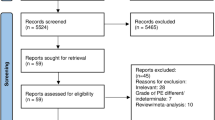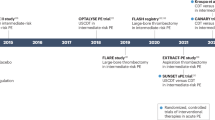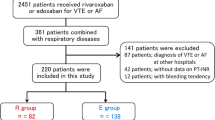Abstract
The clinical presentation of pulmonary embolism (PE) varies widely, ranging from only limited symptoms to severe cardiogenic shock. Treatment of PE comprises initial therapy—with low-molecular-weight heparin (LMWH), fondaparinux, or unfractionated heparin—and long-term treatment, most commonly with vitamin-K antagonists (VKAs). Methods of risk stratification, to determine whether a patient will benefit from thrombolysis, are currently under investigation. However, at present, insufficient evidence exists that hemodynamically stable patients who demonstrate echocardiographic right ventricular strain (submassive PE) benefit from thrombolysis. By contrast, thrombolysis is a widely accepted treatment strategy for patients with hemodynamic shock (massive PE). The duration of VKA treatment is commonly 3–12 months and depends on the type of PE and on the balance between the risks of recurrent PE, major bleeding, and the patient's preference. In patients with a malignancy, treatment with LMWH during the first 6 months after diagnosis of PE is recommended. Several new oral anticoagulants, such as factor IIa and factor Xa inhibitors, are now being investigated. For prevention of recurrent PE in situations where anticoagulation is contraindicated, a temporary inferior vena cava filter might be useful. Some patients with PE can be safely treated at home, but few outcome studies in this setting have been published.
Key Points
-
Pulmonary embolism (PE) can be effectively treated with anticoagulant medication
-
Initial therapy for PE comprises low-molecular-weight heparin, unfractionated heparin, or fondaparinux, and is followed by long-term treatment with oral vitamin-K antagonists
-
Duration of long-term anticoagulation is usually 3–12 months and depends on type of PE, risk of recurrence, risk of major bleeding, and the patient's preference
-
Tailoring the duration of treatment using biomarkers, such as D-dimer level or presence of residual vein thrombosis, is not yet recommended
-
Patients with PE who are hemodynamically unstable (massive PE) should be treated with thrombolysis
-
Currently, insufficient evidence exists that hemodynamically stable patients with right ventricular dysfunction (submassive PE) benefit from thrombolysis
This is a preview of subscription content, access via your institution
Access options
Subscribe to this journal
Receive 12 print issues and online access
$209.00 per year
only $17.42 per issue
Buy this article
- Purchase on Springer Link
- Instant access to full article PDF
Prices may be subject to local taxes which are calculated during checkout



Similar content being viewed by others
References
Goldhaber, S. Z., Visani, L. & De, Rosa. M. Acute pulmonary embolism: clinical outcomes in the International Cooperative Pulmonary Embolism Registry (ICOPER). Lancet 353, 1386–1389 (1999).
White, R. H. The epidemiology of venous thromboembolism. Circulation 107 (Suppl. 1), I4–I8 (2003).
US Department of Health and Human Services. The Surgeon General's call to action to prevent deep vein thrombosis and pulmonary embolism, [online] (2008).
Douma, R. A., Kamphuisen, P. W. & Büller, H. R. Acute pulmonary embolism. Part 1: epidemiology and diagnosis. Nat. Rev. Cardiol. doi:10.1038/nrcardio.2010.106.
Sanchez, O. et al. Prognostic factors for pulmonary embolism: the PREP study, a prospective multicenter cohort study. Am. J. Respir. Crit. Care Med. 181, 168–173 (2010).
Barritt, D. W. & Jordan, S. C. Anticoagulant drugs in the treatment of pulmonary embolism. A controlled trial. Lancet 1, 1309–1312 (1960).
Task Force on Pulmonary Embolism, European Society of Cardiology. Guidelines on diagnosis and management of acute pulmonary embolism. Eur. Heart J. 21, 1301–1336 (2000).
Konstantinides, S. Pulmonary embolism: impact of right ventricular dysfunction. Curr. Opin. Cardiol. 20, 496–501 (2005).
Kasper, W. et al. Management strategies and determinants of outcome in acute major pulmonary embolism: results of a multicenter registry. J. Am. Coll. Cardiol. 30, 1165–1171 (1997).
Gibson, N. S., Sohne, M. & Büller, H. R. Prognostic value of echocardiography and spiral computed tomography in patients with pulmonary embolism. Curr. Opin. Pulm. Med. 11, 380–384 (2005).
Kucher, N., Rossi, E., De Rosa, M. & Goldhaber, S. Z. Prognostic role of echocardiography among patients with acute pulmonary embolism and a systolic arterial pressure of 90 mmHg or higher. Arch. Intern. Med. 165, 1777–1781 (2005).
van der Meer, R. W. et al. Right ventricular dysfunction and pulmonary obstruction index at helical CT: prediction of clinical outcome during 3-month follow-up in patients with acute pulmonary embolism. Radiology 235, 798–803 (2005).
Vuilleumier, N. et al. Correlation between cardiac biomarkers and right ventricular enlargement on chest CT in nonmassive pulmonary embolism. Thromb. Res. 121, 617–624 (2008).
Becattini, C., Vedovati, M. C. & Agnelli, G. Prognostic value of troponins in acute pulmonary embolism: a meta-analysis. Circulation 116, 427–433 (2007).
Ten Wolde, M. et al. Brain natriuretic peptide as a predictor of adverse outcome in patients with pulmonary embolism. Circulation 107, 2082–2084 (2003).
Kostrubiec, M. et al. Biomarker-based risk assessment model in acute pulmonary embolism. Eur. Heart J. 26, 2166–2172 (2005).
Douma, R. A. & Kamphuisen, P. W. Thrombolysis for pulmonary embolism and venous thrombosis: is it worthwhile? Semin. Thromb. Hemost. 33, 821–828 (2007).
Kearon, C. et al. Antithrombotic therapy for venous thromboembolic disease: American College of Chest Physicians evidence-based clinical practice guidelines (8th edition). Chest 133, 454S–545S (2008).
Kearon, C. et al. Comparison of fixed-dose weight-adjusted unfractionated heparin and low-molecular-weight heparin for acute treatment of venous thromboembolism. JAMA 296, 935–942 (2006).
Quinlan, D. J., McQuillan, A. & Eikelboom, J. W. Low-molecular-weight heparin compared with intravenous unfractionated heparin for treatment of pulmonary embolism: a meta-analysis of randomized, controlled trials. Ann. Intern. Med. 140, 175–183 (2004).
Büller, H. R. et al. Subcutaneous fondaparinux versus intravenous unfractionated heparin in the initial treatment of pulmonary embolism. N. Engl. J. Med. 349, 1695–1702 (2003).
Hoy, S. M., Scott, L. J. & Plosker, G. L. Tinzaparin sodium: a review of its use in the prevention and treatment of deep vein thrombosis and pulmonary embolism, and in the prevention of clotting in the extracorporeal circuit during haemodialysis. Drugs 70, 1319–1347 (2010).
Schulman, S., Beyth, R. J., Kearon, C. & Levine, M. N. Hemorrhagic complications of anticoagulant and thrombolytic treatment: American College of Chest Physicians evidence-based clinical practice guidelines (8th edition). Chest 133, 257S–298S (2008).
Büller, H. R., Sohne, M. & Middeldorp, S. Treatment of venous thromboembolism. J. Thromb. Haemost. 3, 1554–1560 (2005).
Warkentin, T. E. et al. Heparin-induced thrombocytopenia in patients treated with low-molecular-weight heparin or unfractionated heparin. N. Engl. J. Med. 332, 1330–1335 (1995).
Savi, P. et al. Effect of fondaparinux on platelet activation in the presence of heparin-dependent antibodies: a blinded comparative multicenter study with unfractionated heparin. Blood 105, 139–144 (2005).
Warkentin, T. E. et al. Gender imbalance and risk factor interactions in heparin-induced thrombocytopenia. Blood 108, 2937–2941 (2006).
Greinacher, A. et al. Clinical features of heparin-induced thrombocytopenia including risk factors for thrombosis. A retrospective analysis of 408 patients. Thromb. Haemost. 94, 132–135 (2005).
Warkentin, T. E. & Greinacher, A. Heparin-induced thrombocytopenia: recognition, treatment, and prevention: the Seventh ACCP Conference on Antithrombotic and Thrombolytic Therapy. Chest 126, 311S–337S (2004).
Grifoni, S. et al. Short-term clinical outcome of patients with acute pulmonary embolism, normal blood pressure, and echocardiographic right ventricular dysfunction. Circulation 101, 2817–2822 (2000).
Stein, P. D. et al. Enlarged right ventricle without shock in acute pulmonary embolism: prognosis. Am. J. Med. 121, 34–42 (2008).
Konstantinides, S., Geibel, A., Heusel, G., Heinrich, F. & Kasper, W. Heparin plus alteplase compared with heparin alone in patients with submassive pulmonary embolism. N. Engl. J. Med. 347, 1143–1150 (2002).
Wan, S., Quinlan, D. J., Agnelli, G. & Eikelboom, J. W. Thrombolysis compared with heparin for the initial treatment of pulmonary embolism: a meta-analysis of the randomized controlled trials. Circulation 110, 744–749 (2004).
Becattini, C. et al. Bolus tenecteplase for right ventricle dysfunction in hemodynamically stable patients with pulmonary embolism. Thromb. Res. 125, e82–e86 (2010).
Meyer, G. The PEITHO study: for a clarification of the indications for the fibrinolytic treatment of pulmonary embolism [French]. Rev. Pneumol. Clin. 64, 326–327 (2008).
Weitz, J. I. New oral anticoagulants in development. Thromb. Haemost. 103, 62–70 (2010).
Thabut, G. et al. Thrombolytic therapy of pulmonary embolism: a meta-analysis. J. Am. Coll. Cardiol. 40, 1660–1667 (2002).
Büller, H. R. et al. Antithrombotic therapy for venous thromboembolic disease: the Seventh ACCP Conference on Antithrombotic and Thrombolytic Therapy. Chest 126, 401S–428S (2004).
Jerjes-Sanchez, C. et al. Streptokinase and heparin versus heparin alone in massive pulmonary embolism: a randomized controlled trial. J. Thromb. Thrombolysis 2, 227–229 (1995).
Wan, S., Quinlan, D. J., Agnelli, G. & Eikelboom, J. W. Thrombolysis compared with heparin for the initial treatment of pulmonary embolism: a meta-analysis of the randomized controlled trials. Circulation 110, 744–749 (2004).
Kucher, N., Rossi, E., De Rosa, M. & Goldhaber, S. Z. Massive pulmonary embolism. Circulation 113, 577–582 (2006).
Dong, B., Jirong, Y., Liu, G., Wang, Q. & Wu, T. Thrombolytic therapy for pulmonary embolism. Cochrane Database Syst. Rev., Issue 8. Art. No.: CD004437. doi:10.1002/14651858.CD004437.pub3 (2006).
Obermaier, R. et al. Successful catheter-guided local thrombolysis in acute pulmonary embolism in the early postoperative period after pancreatic head resection [German]. Chirurg. 73, 945–949 (2002).
Kelly, P., Carroll, N., Grant, C., Barrett, C. & Kocka, V. Successful treatment of massive pulmonary embolism with prolonged catheter-directed thrombolysis. Heart Vessels 21, 124–126 (2006).
Goldhaber, S. Z. Advanced treatment strategies for acute pulmonary embolism, including thrombolysis and embolectomy. J. Thromb. Haemost. 7 (Suppl. 1), 322–327 (2009).
Kucher, N. Catheter embolectomy for acute pulmonary embolism. Chest 132, 657–663 (2007).
Morshuis, W. J., Jansen, E. W., Vincent, J. G., Heystraten, F. M. & Lacquet, L. K. Intraoperative fiberoptic angioscopy to evaluate the completeness of pulmonary embolectomy. J. Cardiovasc. Surg. (Torino) 30, 630–634 (1989).
Mobin-Uddin, K., McLean, R. & Jude, J. R. A new catheter technique of interruption of inferior vena cava for prevention of pulmonary embolism. Am. Surg. 35, 889–894 (1969).
Albers, G. W., Amarenco, P., Easton, J. D., Sacco, R. L. & Teal, P. Antithrombotic and thrombolytic therapy for ischemic stroke: American College of Chest Physicians evidence-based clinical practice guidelines (8th edition). Chest 133, 630S–669S (2008).
Joels, C. S., Sing, R. F. & Heniford, B. T. Complications of inferior vena cava filters. Am. Surg. 69, 654–659 (2003).
Mission, J. F., Kerlan, R. K. Jr,, Tan, J. H. & Fang, M. C. Rates and predictors of plans for inferior vena cava filter retrieval in hospitalized patients. J. Gen. Intern. Med. 25, 321–325 (2010).
Ingber, S. & Geerts, W. H. Vena caval filters: current knowledge, uncertainties and practical approaches. Curr. Opin. Hematol. 16, 402–406 (2009).
Young, T., Tang, H. & Hughes, R. Vena caval filters for the prevention of pulmonary embolism. Cochrane Database Syst. Rev., Issue 2. Art. No.: CD006212. doi:10.1002/14651858.CD006212.pub3 (2010).
PREPIC Study Group. Eight-year follow-up of patients with permanent vena cava filters in the prevention of pulmonary embolism: the PREPIC (Prevention du Risque d'Embolie Pulmonaire par Interruption Cave) randomized study. Circulation 112, 416–422 (2005).
Couturaud, F. & Kearon, C. Optimum duration of anticoagulant treatment after an episode of venous thromboembolism [French]. Rev. Pneumol. Clin. 64, 305–315 (2008).
Baglin, T., Luddington, R., Brown, K. & Baglin, C. Incidence of recurrent venous thromboembolism in relation to clinical and thrombophilic risk factors: prospective cohort study. Lancet 362, 523–526 (2003).
Schulman, S. et al. A comparison of six weeks with six months of oral anticoagulant therapy after a first episode of venous thromboembolism. Duration of Anticoagulation Trial Study Group. N. Engl. J. Med. 332, 1661–1665 (1995).
Campbell, I. A. et al. Anticoagulation for three versus six months in patients with deep vein thrombosis or pulmonary embolism, or both: randomised trial. BMJ 334, 674 (2007).
Pinede, L. et al. Comparison of 3 and 6 months of oral anticoagulant therapy after a first episode of proximal deep vein thrombosis or pulmonary embolism and comparison of 6 and 12 weeks of therapy after isolated calf deep vein thrombosis. Circulation 103, 2453–2460 (2001).
Agnelli, G. et al. Three months versus one year of oral anticoagulant therapy for idiopathic deep venous thrombosis. Warfarin Optimal Duration Italian Trial Investigators. N. Engl. J. Med. 345, 165–169 (2001).
van der Meer, F. J., Rosendaal, F. R., Vandenbroucke, J. P. & Briët, E. Bleeding complications in oral anticoagulant therapy. An analysis of risk factors. Arch. Intern. Med. 153, 1557–1562 (1993).
Hull, R. D. et al. Self-managed long-term low-molecular-weight heparin therapy: the balance of benefits and harms. Am. J. Med. 120, 72–82 (2007).
Kamphuisen, P. W. Can anticoagulant treatment be tailored with biomarkers in patients with venous thromboembolism? J. Thromb. Haemost. 4, 1206–1207 (2006).
Palareti, G. et al. Predictive value of D-dimer test for recurrent venous thromboembolism after anticoagulation withdrawal in subjects with a previous idiopathic event and in carriers of congenital thrombophilia. Circulation 108, 313–318 (2003).
Eichinger, S. et al. D-dimer levels and risk of recurrent venous thromboembolism. JAMA 290, 1071–1074 (2003).
Palareti, G. et al. D-dimer testing to determine the duration of anticoagulation therapy. N. Engl. J. Med. 355, 1780–1789 (2006).
Prandoni, P. et al. Residual thrombosis on ultrasonography to guide the duration of anticoagulation in patients with deep venous thrombosis: a randomized trial. Ann. Intern. Med. 150, 577–585 (2009).
Cosmi, B. et al. Residual venous obstruction, alone and in combination with D-dimer, as a risk factor for recurrence after anticoagulation withdrawal following a first idiopathic deep vein thrombosis in the prolong study. Eur. J. Vasc. Endovasc. Surg. 39, 356–365 (2010).
Rodger, M. A. et al. Identifying unprovoked thromboembolism patients at low risk for recurrence who can discontinue anticoagulant therapy. CMAJ 179, 417–426 (2008).
Bourjeily, G., Paidas, M., Khalil, H., Rosene-Montella, K. & Rodger, M. Pulmonary embolism in pregnancy. Lancet 375, 500–512 (2010).
Heit, J. A. et al. Trends in the incidence of venous thromboembolism during pregnancy or postpartum: a 30-year population-based study. Ann. Intern. Med. 143, 697–706 (2005).
Pretorius, E., Bronkhorst, P., Briedenhann, S., Smit, E. & Franz, R. C. Comparisons of the fibrin networks during pregnancy, nonpregnancy and pregnancy during dysfibrinogenaemia using the scanning electron microscope. Blood Coagul. Fibrinolysis 20, 12–16 (2009).
Cordts, P. R. & Gawley, T. S. Anatomic and physiologic changes on the lower extremity venous hemodynamics associated with pregnancy. J. Vasc. Surg. 24, 763–767 (1996).
Pavek, P., Ceckova, M. & Staud, F. Variation of drug kinetics in pregnancy. Curr. Drug Metab. 10, 520–529 (2009).
Bates, S. M., Greer, I. A., Pabinger, I., Sofaer, S. & Hirsh, J. Venous thromboembolism, thrombophilia, antithrombotic therapy, and pregnancy: American College of Chest Physicians evidence-based clinical practice guidelines (8th edition). Chest 133, 844S–886S (2008).
Otten, H. M. et al. Symptomatic venous thromboembolism in cancer patients treated with chemotherapy: an underestimated phenomenon. Arch. Intern. Med. 164, 190–194 (2004).
Chew, H. K., Wun, T., Harvey, D., Zhou, H. & White, R. H. Incidence of venous thromboembolism and its effect on survival among patients with common cancers. Arch. Intern. Med. 166, 458–464 (2006).
Lee, A. Y. et al. Low-molecular-weight heparin versus a coumarin for the prevention of recurrent venous thromboembolism in patients with cancer. N. Engl. J. Med. 349, 146–153 (2003).
Lim, W., Crowther, M. A. & Eikelboom, J. W. Management of antiphospholipid antibody syndrome: a systematic review. JAMA 295, 1050–1057 (2006).
Kearon, C. et al. A comparison of three months of anticoagulation with extended anticoagulation for a first episode of idiopathic venous thromboembolism. N. Engl. J. Med. 340, 901–907 (1999).
Schulman, S., Svenungsson, E. & Granqvist, S. Anticardiolipin antibodies predict early recurrence of thromboembolism and death among patients with venous thromboembolism following anticoagulant therapy. Duration of Anticoagulation Study Group. Am. J. Med. 104, 332–338 (1998).
Weitz, J. I., Middeldorp, S., Geerts, W. & Heit, J. A. American Society of Hematology Education Program Book. Thrombophilia and new anticoagulant drugs. Hematology Am. Soc. Hematol. Educ. Program 424–438 (2004).
Eikelboom, J. W. & Weitz, J. I. New anticoagulants. Circulation 121, 1523–1532 (2010).
Schulman, S. et al. Dabigatran versus warfarin in the treatment of acute venous thromboembolism. N. Engl. J. Med. 361, 2342–2352 (2009).
ClinicalTrials.gov. Clinical Study Assessing SSR126517E Injections Once-weekly in Pulmonary Embolism Therapeutic Approach (CASSIOPEA), [online] (2010).
Markel Vaysman, A. & Nutescu, E. A. YM-150, a factor Xa inhibitor for the prevention of venous thromboembolism and coronary artery disease. Curr. Opin. Investig. Drugs 11, 333–339 (2010).
Otero, R. et al. Home treatment in pulmonary embolism. Thromb. Res. 126, e1–e5 (2010).
Agterof, M. J. et al. Out of hospital treatment of acute pulmonary embolism in patients with a low NT-proBNP level. J. Thromb. Haemost. 8, 1235–1241 (2010).
Hirsh, J. et al. Parenteral anticoagulants: American College of Chest Physicians evidence-based clinical practice guidelines (8th edition). Chest 133, 141S–159S (2008).
Agnelli, G., Becattini, C. & Kirschstein, T. Thrombolysis vs heparin in the treatment of pulmonary embolism: a clinical outcome-based meta-analysis. Arch. Intern. Med. 162, 2537–2541 (2002).
Acknowledgements
D. Lie, University of California, Irvine, CA, is the author of and is solely responsible for the content of the learning objectives, questions and answers of the MedscapeCME-accredited continuing medical education activity associated with this article.
Author information
Authors and Affiliations
Contributions
J. van Es, R. A. Douma, and P. W. Kamphuisen researched data for the article. J. van Es, R. A. Douma, V. E. A. Gerdes, P. W. Kamphuisen, and H. R. Büller contributed to the discussion of content. J. van Es and R. A. Douma wrote the article. J. van Es, R. A. Douma, V. E. A. Gerdes, P. W. Kamphuisen, and H. R. Büller reviewed the manuscript before submission. J. van Es revised the article in response to peer-review and editorial comments.
Corresponding author
Ethics declarations
Competing interests
The authors declare no competing financial interests.
Rights and permissions
About this article
Cite this article
van Es, J., Douma, R., Gerdes, V. et al. Acute pulmonary embolism. Part 2: treatment. Nat Rev Cardiol 7, 613–622 (2010). https://doi.org/10.1038/nrcardio.2010.141
Published:
Issue Date:
DOI: https://doi.org/10.1038/nrcardio.2010.141
This article is cited by
-
Serum microRNA-1233 is a specific biomarker for diagnosing acute pulmonary embolism
Journal of Translational Medicine (2016)
-
The non-immunosuppressive management of childhood nephrotic syndrome
Pediatric Nephrology (2016)



